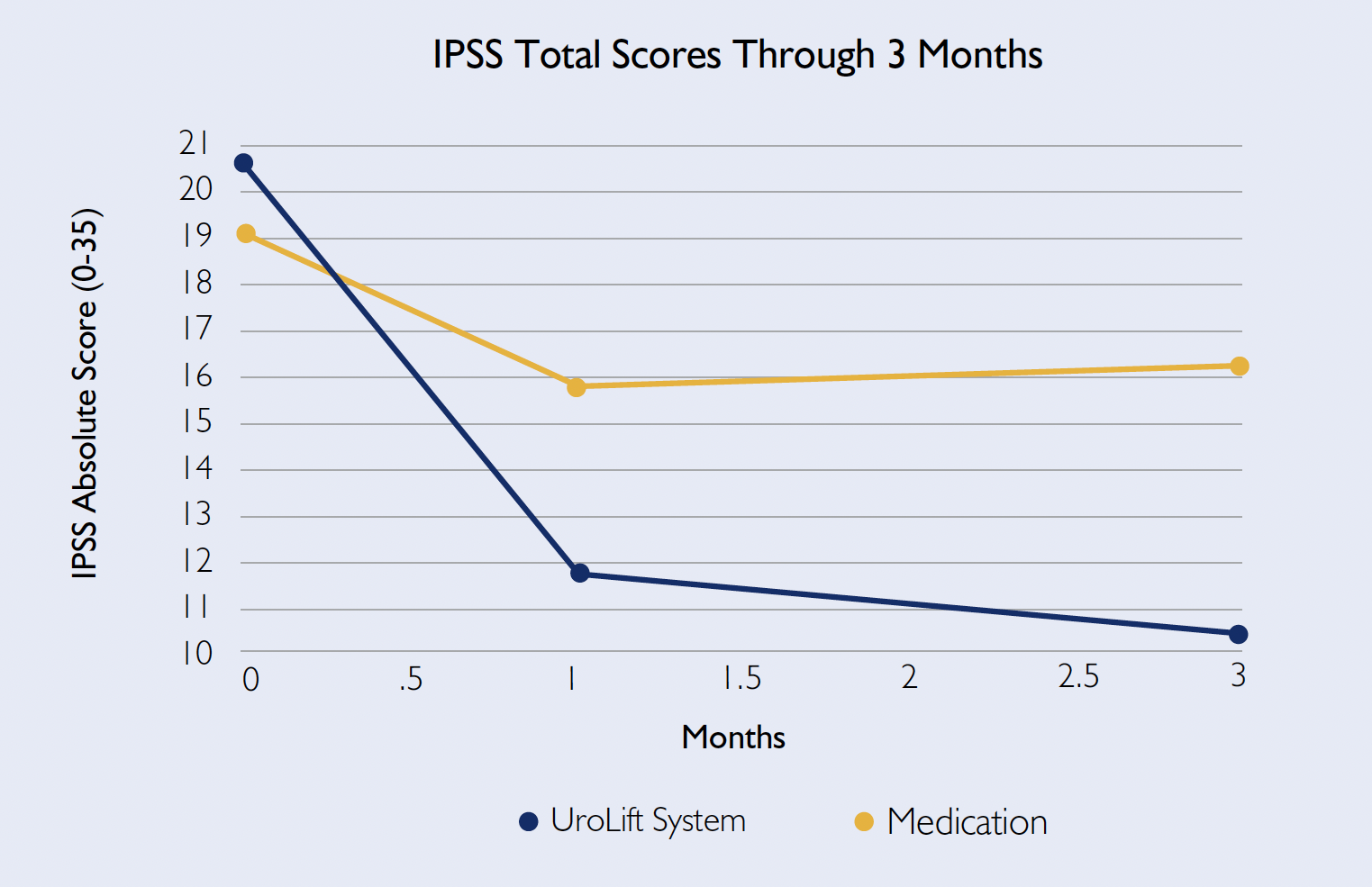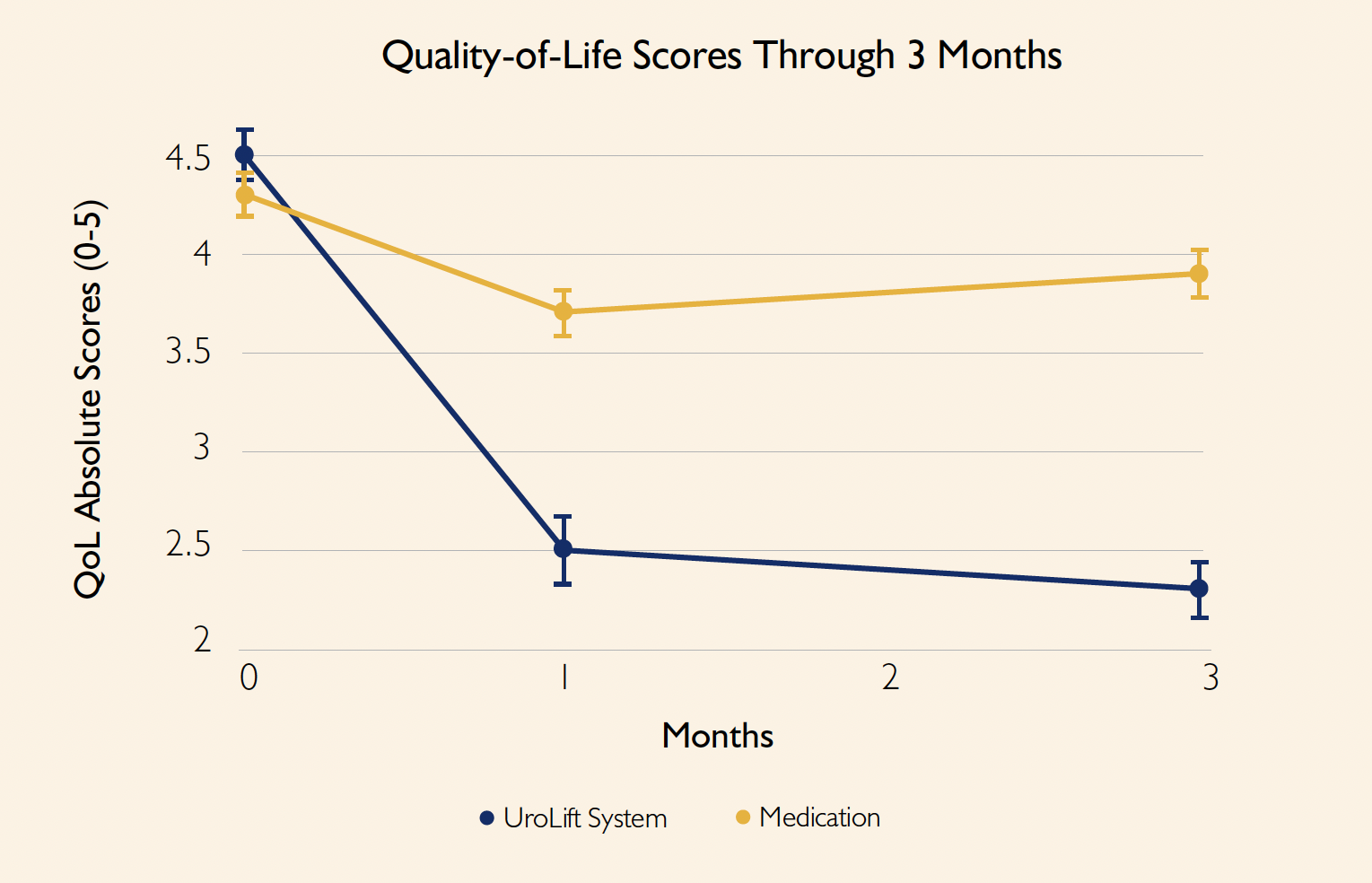What Are the Treatment Options?
-
Non-Invasive
Medication & Monitoring
Alpha-blockers can help relax the muscles around the neck of the bladder to aid urination, while alpha-reductase inhibitors can help to shrink the prostate.
Patients need to continue taking medication to manage their condition, which may lead to common side effects including dizziness, fatigue, and sexual dysfunction.2,3 -
Minimally Invasive
Prostatic Urethral Lift (PUL) – Using the UroLift® System
A straightforward procedure that deploys small implants to lift and compress the sides of the prostate to make the urethra wider and increase the flow of urine.
As PUL does not remove or damage prostate tissue, it can better preserve sexual function compared to other procedures. Side effects are mild to moderate and transient, e.g., urgency to urinate, pain with urination, and pelvic discomfort.1,3 -
Thermotherapies & Lasers
An array of semi-invasive procedures involving the removal of prostate tissue via heat, steam, or lasers to relieve symptoms.
Patients often need to have a catheter inserted into their bladder during the recovery process.
In addition to side effects involving urgency to urinate and pain with urination, these procedures also have incidences of erectile and/or ejaculatory dysfunction.2,3 -
Most Invasive
Surgery
Transurethral resection of the prostate (TURP) involves using a superheated thin metal band to cut and remove prostate tissue. In severe cases with very large prostate or complications, open surgery is needed to reach the prostate.
Surgery requires recovery in the hospital with a catheter inserted into the bladder. Surgery also has higher incidences of bleeding, erectile and/or ejaculatory dysfunction.3
A proven earlier treatment alternative to BPH medications2
The only leading BPH minimally invasive surgical therapy (MIST) with consistent durability in the real-world and clinical trials2,3
A safe, effective treatment,2 providing a superior patient experience* among leading BPH procedures3-5
One of the most studied BPH MIST procedures with 145+ peer reviewed and clinical publications
A Proven Earlier Treatment Alternative to Medications2
98%
of men seeing a doctor for BPH are treated with medications or watchful waiting1Medications like alpha blockers, 5-ARIs or combination therapy are first-line treatment for patients with BPH symptoms, but they come with some significant tradeoffs.
Maximum median IPSS score reduction for common BPH medications is only 7 points while placebo provided 4-point improvement at 4 years6
Lifelong treatment and side effects7-16
Low compliance17
Long-term use of BPH medication may lead to bladder dysfunction18
The IMPACT Study
Read StudyThis study represents the largest head-to-head RCT comparing efficacy, safety and patient experience* after UroLift™ PUL and medical therapy (alpha blocker Tamsulosin).29 Preliminary data suggest that UroLift™ PUL yields advantages in the first three months:
- Better symptom relief and quality of life improvements29
- Higher patient satisfaction and goal attainment29
- More improvements in daily activities29

UroLift™ System PUL patients experienced improvements of 8.6 and 10 in IPSS total score at 1 and 3 months, respectively, compared to 3.4 and 3.1 for medication.29

UroLift™ System PUL QoL scores improved 2.0 (39.3%) and 2.2 (47.9%) vs. 0.6 (10.2%) and 0.5 (7.8%) for medication at 1 and 3 months.29
1 in 20
Did you know? New data shows that within one year of BPH surgery, 1 in 20 patients may require retreatment regardless of the procedure type.3
View the StudyReal-World Durability Analysis
Note: This webinar counts toward continuing education requirements for the UroLift™ System Center of Excellence program. To receive credit for watching the webinar, please view in UroLift University.
The Only Leading BPH MIST With Consistent Durability in Real World and Clinical Trials2,3
In a recent real-world analysis, the UroLift™ System demonstrated a comparable 5-year retreatment rate to the rate shown in the L.I.F.T. RCT (11.6% and 13.6%).2,3
Across clinical trials and real-world studies, the UroLift™ System has demonstrated largely consistent IPSS outcomes.2,21
5-year surgical retreatment rate vs. L.I.F.T. RCT surgical retreatment rate2,3

Provides Superior Patient Experience* Among Leading BPH Procedures3-5

Rapid relief with a low risk profile22-23
Lowest catheter rate of the leading BPH procedures2,23-27

Preservation of sexual function***2
Patient Safety
Once procedure volume is factored in, the UroLift™ System has the lowest rates of mild, moderate, and severe complications on a per case basis from 2019-202228
The UroLift™ System had the lowest post-procedural complication rate at one year compared to other procedures.3
MAUDE Study: Patient Safety
Note: This webinar counts toward continuing education requirements for the UroLift™ System Center of Excellence program. To receive credit for watching the webinar, please view in UroLift University.
Learn More About the UroLift™ System Procedure and the Latest Data
*Patient experience defined as a combination of rapid symptom relief, low risk profile, and preservation of sexual function
**De novo ED or EjD among sexually active men
***No instances of new, sustained erectile or ejaculatory dysfunction in the L.I.F.T. pivotal study
+While the MAUDE Database is a powerful resource, it is subject to certain limitations. These include the potential for underreporting of adverse events and the variability in the quality and consistency of the information reported. MAUDE data does not represent all known safety information for a reported medical device and should be interpreted in the context of other available information when making device-related or treatment decisions.
References
1.
U.S. 2022 estimates based on US Market Model 2022-24 (5-17-22 FINAL), which is in part based on Symphony Health PatientSource® 2018-21, as is and with no representations/ warranties, including accuracy or completeness.
2.
Roehrborn et al. Can J Urol 2017
3.
Kaplan, Prostate Cancer Prostatic Dis 2023
4.
Gratzke, BJU Int 2016
5.
Tutrone, Can J Urol 2020
6.
McConnell, NEJM 2003
7.
AUA BPH Guidelines, 2003, 2010
8.
Chang DF, Campbell JR, J Cataract Refract Surg. 2005 Apr; 31(4): 664-673
9.
Lai et al, CMAJ. 2016 Mar 01; 188(4): 255-260
10.
Duan et al, Pharmacoepidemiol Drug Saf. 2018 Mar; 27(3): 340-348
11.
Welk et al, JAMA Intern Med. 2017 May 1; 177(5): 683-691
12.
Traish et al, Horm Mol Biol Clin Investig. 2017 Jun 21; 30(3): 1-16
13.
Wei et al, BMJ. 2019 Apr 10; 365:I12049
14.
Welk et al, J Neurol Sci. 2017 Aug 15; 379: 109-111
15.
S. Diviccaro, et al. Neurobiology of Stress 12 2020
16.
Lusty, J Urol 2021
17.
Cindolo, Eur Urol 2015
18.
Young et al. The Changing Practice of Transurethral Resection of the Prostate, Ann. R. Coll Surg England, 2018
19.
Gilling, Can J Urol 2022
20.
Gilling, J Urol 2018
21.
Eure, J Endourol 2019
22.
Roehrborn, J Urol 2013
23.
Shore, Can J Urol 2014
24.
Bachmann, Eur Urol 2013
25.
McVary, J Urol 2016
26.
Mollengarden, Prostate Cancer Prostatic Dis 2018
27.
Das, Can J Urol 2019
28.
Shinghal R, Ashley M, Eure G (2023). Total Procedural Context is Crucial in Understanding BPH Treatment Device Safety in the FDA’s MAUDE Database. (Manuscript in preparation)
29.
Roehrborn, et al, AUA 2024.Preliminary RCT Analysis of Minimally Invasive Surgery vs. Medication in the Initial Treatment of BPH-Associated LUTS. AUA Study sponsored by Teleflex Incorporated or its affiliates.
30.
Mayo Clinic, Patient Care & Health Information, Diseases & Conditions, Benign prostatic hyperplasia (BPH). Accessed 1 Dec 2021
Healthcare Professional Confirmation
The information on the page you are about to enter is intended for Healthcare Professionals
only.
By clicking the box below, you confirm that you are a Healthcare Professional.

